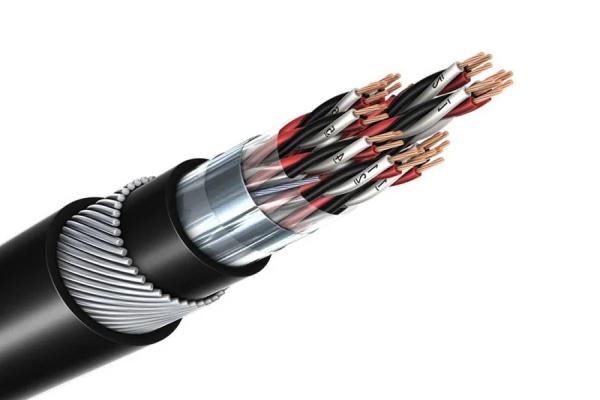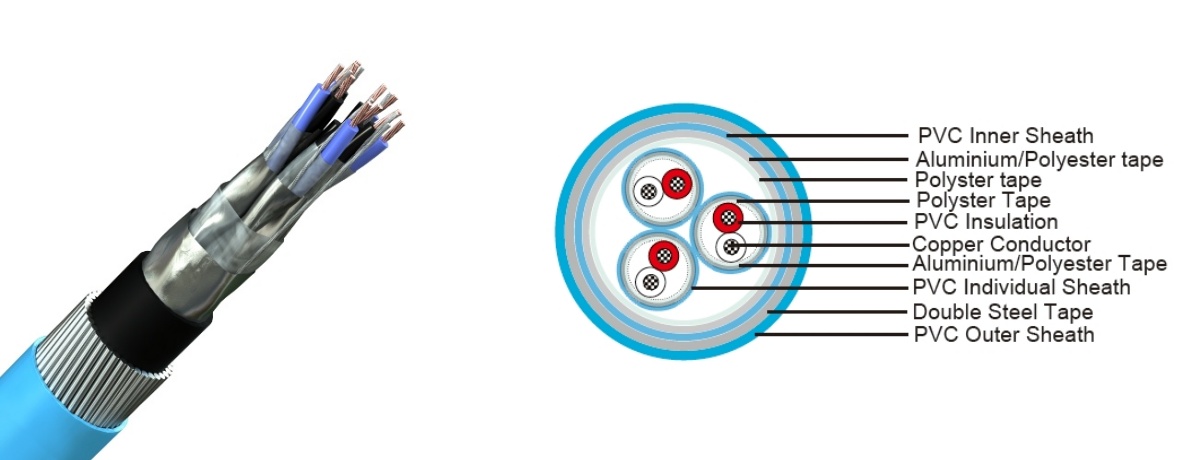

Is comhpháirteanna criticiúla iad cáblaí ionstraimíochta i suíomhanna tionsclaíocha agus tráchtála, a úsáidtear chun sonraí agus comharthaí a tharchur le haghaidh monatóireachta agus rialaithe trealaimh. Tá siad deartha chun sláine comhartha a choinneáil i dtimpeallachtaí a d'fhéadfadh torann leictreach a chur i láthair, strus meicniúil, agus guaiseacha comhshaoil. Tá na cáblaí seo ríthábhachtach i bpróisis bheacht rialaithe agus tomhais, mar shampla i bplandaí ceimiceacha, giniúint cumhachta, tionscail ola agus gáis, agus córais uathoibrithe. An aiste seo Scrúdaíonn Veri Cable na cineálacha éagsúla cáblaí ionstraimíochta, a gcuid samhlacha sonracha, Agus a n -iarratais, a dtábhacht a aibhsiú i dtírdhreacha teicneolaíochta nua -aimseartha.


Tagann cáblaí ionstraimíochta i bhfoirmíochtaí éagsúla, gach ceann acu deartha chun riachtanais shonracha a chomhlíonadh. I measc na bpríomhchineálacha tá:
Is éard atá i gcáblaí péireáilte dhá sheoltóir inslithe atá casta le chéile. Cuidíonn an chumraíocht seo le cur isteach leictreamaighnéadach a íoslaghdú (IEA) agus crosstalk idir péirí in aice láimhe. Tá casadh na bpéirí riachtanach chun sláine comhartha a choinneáil thar achair fhada.
Feidhmchláir:
Is éard atá i gcáblaí triad ná trí sheoltóir inslithe atá casta le chéile. Tá an chumraíocht triad thar a bheith úsáideach in iarratais a éilíonn ilchosáin chomharthaíochta laistigh de chábla amháin, ag laghdú an gá le rothair ilchábla.
Feidhmchláir:
Is éard atá i gcáblaí ilphéire roinnt péirí seoltóirí casta, ag ceadú ilchomharthaí a tharchur trí chábla amháin. Tá buntáiste ar leith ag na cáblaí seo maidir leis an spás fisiciúil atá ag teastáil le haghaidh sreangaithe a laghdú agus suiteáil a shimpliú.
Feidhmchláir:
Is féidir cáblaí ionstraimíochta a chosaint nó a neamhshuim. Ionchorpraíonn cáblaí sciatha ciseal ábhair seoltaí timpeall na seoltóirí chun cosaint a thabhairt i gcoinne EMI. Cáblaí neamhshábháilte, mar a thugann an t-ainm le fios, Ná bíodh an ciseal seo agat.
Iarratais ar cháblaí sciatha:
Iarratais ar cháblaí neamhshábháilte:
Tá cáblaí síneadh teirmeachúpla deartha go sonrach le haghaidh Teirmeachúpla a nascadh le hionstraimí a thomhas. Caithfear na cáblaí seo a dhéanamh as ábhair atá comhoiriúnach leis an teirmeachúpla chun léamha teochta cruinne a chinntiú.
Feidhmchláir:
Úsáidtear cáblaí allamuigh i ndigiteach, Córais chumarsáide dhá bhealach le haghaidh uathoibriú tionsclaíoch. Cuireann na cáblaí seo ar chumas ilfheistí allamuigh a nascadh ar líonra amháin.
Feidhmchláir:
Tá samhlacha éagsúla cáblaí ionstraimíochta deartha chun caighdeáin agus feidhmchláir shonracha a chomhlíonadh. Áirítear ar na samhlacha seo:
Tá cáblaí PLTC deartha le haghaidh suiteáil i dtrátaí cábla agus timpeallachtaí tionsclaíocha eile. Tá siad oiriúnach do chiorcaid chumhachta agus cloí leis an gCód Náisiúnta Leictreach (NEC) riachtanas.
Feidhmchláir:
Tráidire cáblaí (TC) is cáblaí versatile iad atá deartha le haghaidh suiteála i dtráidirí, seoladáin, agus rásbhealaí eile. Tá siad oiriúnach do raon leathan feidhmeanna tionsclaíocha agus comhlíonann siad riachtanais NEC do cháblaí tráidire.
Feidhmchláir:
Tá cáblaí PLTC cosúil le cáblaí PLTC ach déantar iad a rátáil le haghaidh rianta nochta, Brí is féidir iad a shuiteáil taobh amuigh de thráidire seoladáin nó cábla le haghaidh achair theoranta. Fágann sé seo go bhfuil an tsuiteáil níos solúbtha agus níos éifeachtaí ó thaobh costais de.
Feidhmchláir:
Cineál Tá cáblaí ITC deartha go sonrach le haghaidh feidhmchlár ionstraimíochta agus rialaithe. Tairgeann siad cosaint níos fearr in aghaidh EMI agus tá siad oiriúnach le haghaidh suiteála i dtráidirí, seoladáin, agus rásbhealaí.
Feidhmchláir:
Tá cáblaí ionstraimíochta fíor -riachtanach i dtionscail éagsúla, Tarchur agus rialú cruinn sonraí a chinntiú. I measc roinnt príomhiarratas tá:
Sa tionscal ola agus gáis, Tá cáblaí ionstraimíochta ríthábhachtach chun monatóireacht agus rialú a dhéanamh ar phróisis éagsúla. Úsáidtear iad i:
Bíonn áiseanna giniúna cumhachta ag brath go mór ar cháblaí ionstraimíochta le haghaidh monatóireachta agus rialaithe. I measc na n -iarratas tá:
I dtionscail cheimiceacha agus cógaisíochta, Tá cruinneas agus iontaofacht fíorthábhachtach. Úsáidtear cáblaí ionstraimíochta i:
Braitheann córais uathoibrithe agus rialaithe ar fud na dtionscal éagsúil ar cháblaí ionstraimíochta le haghaidh tarchur iontaofa sonraí.
I measc na n -iarratas tá:
I dteilbheannaíocht, Tá cáblaí ionstraimíochta riachtanach chun sonraí iontaofa a tharchur. I measc na n -iarratas tá:
Tá ról ríthábhachtach ag cáblaí ionstraimíochta in iarratais nua -aimseartha tionsclaíocha agus tráchtála, Tarchur agus rialú sonraí cruinn agus iontaofa a chinntiú. Tá na cineálacha agus na samhlacha éagsúla de cháblaí ionstraimíochta deartha chun riachtanais shonracha a chomhlíonadh, Réitigh a sholáthar do thimpeallachtaí a bhfuil cur isteach ard leictreamaighnéadach orthu, strus meicniúil, agus guaiseacha comhshaoil. Ó thionscail ola agus gáis go giniúint cumhachta, monaraíocht cheimiceach, córais uathoibrithe, agus teileachumarsáid, Tá cáblaí ionstraimíochta fíor -riachtanach chun sláine agus éifeachtúlacht na bpróiseas criticiúil a chothabháil. Cuidíonn tuiscint a fháil ar na cineálacha éagsúla cáblaí ionstraimíochta agus a n -iarratais chun an cábla ceart a roghnú do gach riachtanas sonrach, an fheidhmíocht agus an iontaofacht is fearr a chinntiú.
When people hear the term mineral insulated cable, many immediately think of harsh environments like…
As telecommunication networks and power transmission systems grow rapidly, the demand for reliable and cost-effective…
In large-scale oil and gas projects, industrial cables are not just accessories—they are the "nervous…
In the world of electrical connections, cable lugs—also known as cable ears or cable terminals—a bheidh…
When choosing the right rubber cable for an electrical engineering project, it is critical to…
Comhpháirtithe agus custaiméirí a chara: 29 Eanáir, 2025 Is í an Bhliain Nua Lunar na Síne – Spring…